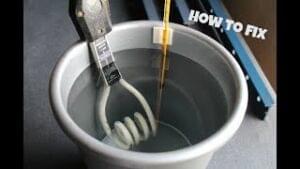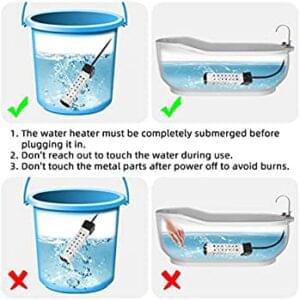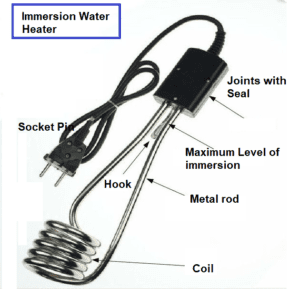
- An immersion water heater is a simple and portable device used to heat water by immersing it directly into a container, such as a bucket, bathtub, or vessel.
- Here’s how an immersion water heater works:
Heating Element:
-
- The immersion water heater consists of a heating element, typically made of metal like stainless steel or copper.
- This element is designed to resist the flow of electrical current, which generates heat as a result of electrical resistance.
Power Cord:
-
- The immersion heater is equipped with a power cord that you can plug into a standard electrical outlet.
- The other end of the cord is connected to the heating element.
Immersion in Water
- To use the immersion water heater, you immerse it completely in the water that you want to heat.
- It’s crucial to ensure that the heating element is fully submerged in water before plugging it in.
- Submerging the heating element ensures efficient heat transfer and prevents damage to the element.
Turning On:
- Once the immersion heater is properly immersed in the water, you plug it into the electrical outlet. Electricity flows through the heating element, and as it encounters resistance, it begins to heat up.
- Heating Process:
- The heating element quickly heats the water surrounding it. The hot water then rises, creating a convection current that circulates the water and ensures even heating throughout the container. The heater continues to heat the water until it reaches the desired temperature.
Thermostat (Optional):
- Some immersion heaters come with an adjustable thermostat, allowing you to set the desired water temperature. If equipped with a thermostat, the immersion heater will automatically turn off when the water reaches the set temperature and turn back on if the water cools down.
Safety Precautions:
- It’s essential to follow safety precautions when using an immersion heater.
- It is always ensure that the heating element is fully submerged in water before plugging it in.
- Never operate an immersion heater outside of water, as it can overheat and become damaged.
Unplugging and Removal:
- Once the water has reached the desired temperature or your heating needs are met, unplug the immersion heater from the electrical outlet. Carefully remove the heater from the water, allowing it to cool down before storage.
- Immersion water heaters are convenient for quickly heating small to medium amounts of water, making them useful for tasks like heating water for bathing, washing dishes, or brewing hot beverages. They are portable and handy for situations where a dedicated water heating system may not be available or necessary.
- The immersion water heater is dipped in the water to heat
Parts of the Immersion Water Heater
There are following main parts of electrical heaters as per manufacturing.
- Copper flange
- Copper material tube
- High-strength alloy wire
- High-temperature resistance Magnetism oxide
An immersion water heater is a simple device with a few basic parts. Here are the main components of an immersion water heater:
Heating Element:
- This is the primary component responsible for heating the water.
- It is typically a metal rod or coil made of materials like stainless steel or copper.
- The heating element has electrical resistance, which causes it to generate heat when an electrical current passes through it.
Power Cord:
- The immersion water heater is equipped with a power cord that has a plug on one end for connecting to a standard electrical outlet.
- The other end of the cord is connected to the heating element.
Handle or Hanger:
- Many immersion heaters have a handle or hanger at the top, which allows you to easily immerse and remove the heater from the water.
- This handle is typically made of heat-resistant material for safe handling.
Thermostat (Optional):
- Some immersion heaters come with an adjustable thermostat.
- The thermostat allows you to set the desired water temperature.
- If equipped with a thermostat, the immersion heater will automatically turn off when the water reaches the set temperature and turn back on if the water cools down.
Protective covers and Indicators
- Protective Cover (Optional): Some immersion heaters have a protective cover or guard around the heating element. This cover helps prevent direct contact between the heating element and the container, reducing the risk of damage to the element and improving safety.
- Indicator Light (Optional): In some models, there may be an indicator light on the power cord or handle to show when the heater is active and heating the water.
- Power Switch (Optional): Certain immersion heaters have an on/off switch on the power cord for added convenience. This allows you to turn the heater on and off without unplugging it from the outlet.
- Temperature Control Knob (Optional): In heaters with a thermostat, there may be a temperature control knob that allows you to adjust the desired water temperature.
Types Immersion Water Heater
The four categories are
- Simple Heating Coil immersion
- Screw-type Heating Coil
- Steel Gaurd Immersion Water Heater
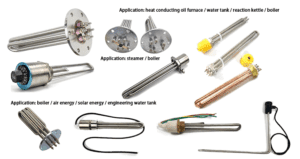
Steel Gaurd Immersion Water Heater

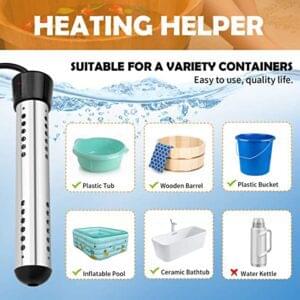
Is an immersion heater Safe?
- An immersion rod/water heater with an auto cut-off feature is better in terms of safety than a regular immersion rod.
- it is the most affordable and cost-efficient water heating option available in India
- If you can’t afford a geyser then this is the best option for you.
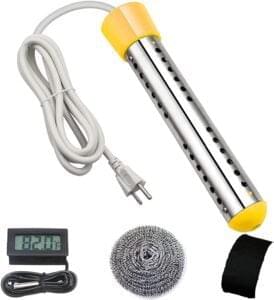
What are the Advanatge of immersion water heater?
- Low Cost and Portable
- Efficient and quick hot water supply
- Fast heat transfer
- Less usage of electricity in fact saving of cost
- Super easy to carry and needs less space
- Economically compared to geysers
- Immersion rods are highly energy efficient.
What are Safety precautions?
What are the safety rules for an immersion heater?
- Under all conditions, the level of the fluid to be heated must lie below the maximum permitted level. …
- These heaters are not to be left unattended. …
- Under all circumstances, the controlling part of the heater should be kept dry and free from moisture.
Electric Wiring Diagram
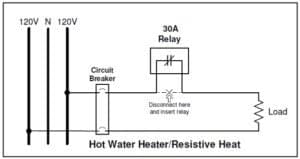
Applications of Immersion Water heaters
Immersion water heaters come in different types, each designed for specific applications and heating needs. Here are some common types of immersion water heaters:
- Bucket Immersion Heater:
- This is a compact and portable immersion heater designed to heat water in a bucket or small container.
- It is often used for tasks like heating water for bathing, washing dishes, or brewing hot beverages.
- Bucket immersion heaters are simple and easy to use.
- Bathtub Immersion Heater:
- These immersion heaters are longer and are designed to heat larger volumes of water in a bathtub.
- They are convenient for quickly warming up bathwater.
- Submersible Aquarium Heater:
- These immersion heaters are specifically designed for aquariums.
- They are waterproof and maintain a consistent water temperature for fish and aquatic plants.
- They are available in various wattages to suit different tank sizes.
- Boiler Immersion Heater:
- Boiler immersion heaters are used for heating water in larger vessels or tanks, such as industrial boilers, large-scale water heaters, or process tanks.
- They are powerful and are often used in commercial and industrial settings.
- Flanged Immersion Heater:
- Flanged immersion heaters are designed to be installed directly into the flange of a tank or vessel.
- They are commonly used for heating oil, chemicals, and other liquids in industrial processes. They are available in various configurations, including screw-plug and flange-mounted.
- Cartridge Immersion Heater:
- Cartridge immersion heaters consist of a cylindrical heating element that is inserted into a tube or well in a tank.
- They are versatile and can be used for heating a wide range of liquids, including oils, water, and chemicals.
- Over-the-Side Immersion Heater:
- These heaters are designed to hang over the side of a tank or container.
- They are commonly used for heating smaller tanks and are easy to install and remove.
- Circulation Immersion Heater:
- Circulation immersion heaters are equipped with a pump that circulates the liquid through the heating element.
- They are often used in industrial applications where continuous circulation and precise temperature control are required.
- Inline Immersion Heater:
- Inline immersion heaters are installed in the flow path of a liquid, such as in pipelines.
- They heat the liquid as it flows through the heater, making them suitable for process heating applications.
- Digital Immersion Heater: Some modern immersion heaters come with digital controls, timers, and temperature displays, allowing for precise temperature adjustment and monitoring.
How Do We Shortlist The Best Geysers
We shortlist the best geysers by taking into account these features:
Customers Requirement
- The number of people in the home and the intended usage dictate the size of the geyser
- A water heater with a greater capacity will be more helpful if your household is large
- If you have a small family, choosing a compact water heater is also advantageous.
Overall Customer Feedback
- The king of the market is the consumer
- Collect feedback based on customers’ usage, reviews, and after-sale support
Quality And Durability
- Customers must be prioritized service quality and durability of heater parts
- Understand which company has customer service and quality through
- Avoid alluring unnecessary offers, adaptable rules
Geyser Performance
- Electric water heaters may cause a 15% increase in your electricity costs.
- Hence when looking for a water heater, you should be aware of it and purchase a geyser that does not burn a hole in your pocket.
Ease Of Use
- Most modern water heaters come equipped with user-friendly safety features like thermostats
- Multi-function safety valves to provide the highest level of protection.
Major types of Geysers Available
Here is a guide that outlines considerations before making a geyser purchase during the winter
Electric Geysers
- They are designed for immediate use and can instantly heat water
- In addition, they take up less space because of their compact form
- The tankless or quick water heater is another name for the electric geyser. You can refer the post for details of geysers.
Storage Geysers
- Storage geysers, as opposed to electric geysers, have an integrated, insulated water tank
- These geysers, which are the most prevalent, have a reservoir of hot water that is available for use until it is stored.
Gas Geysers
- Gas geysers are energy-efficient and run on LPG and propane gas
- It is crucial to install the gas geyser next to the LPG gas cylinder and supply it through gas pipelines.
An Easy Guide On How To Choose The Best Geysers
Before making a purchase, always examine the manufacturer’s warranty details twice.
- Rust-proof and shockproof ABS plastic makes up the body.
- A safety valve drains the extra water when the pressure or temperature exceeds acceptable thresholds.
Frequently Asked Questions while Purchasing A New Geyser
Here are our answers to some of the most commonly asked questions about purchasing the best geysers in India (2022).
Are geysers energy-efficient?
- Geysers can save energy if you know well its usage
- Do not overheat water than need
- .In general, family utilizes between 30% and 65% of the electricity may be consumed each month
How long do geysers last?
- Geysers last about five years, during which time they corrode
- Homeowners can extend the life of their geysers by giving them the proper care.
How to select the best Litre geyser?
The following things you must check while buying an electric water heater
- Select warranty of heating coil (at least 3 years)
- Check the water heating capacity
- Electricity consumption and safety record
- Strong sturdy insulation
- Three-pin water heater
- Minimum use of plastic for insulation
Conclusion
- Water heaters are essential in every household, especially in places that experience extreme winters.
- The best water heater will serve its purpose while being economical and durable
- Select the best geysers for your need and without compromising in safety
- The choice of immersion water heater depends on factors such as the volume of water to be heated, the type of liquid, the intended application, and the specific heating requirements.
- It’s essential to select the right type of immersion heater to ensure efficient and safe water heating.

